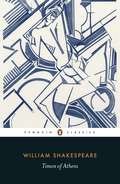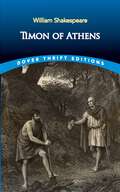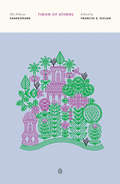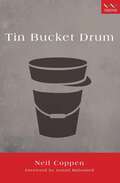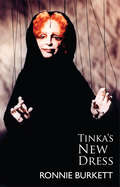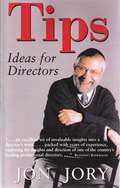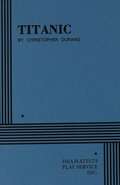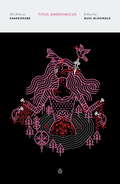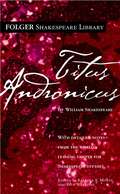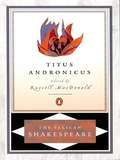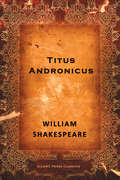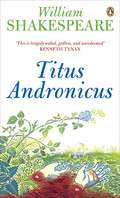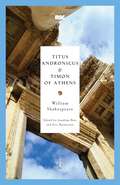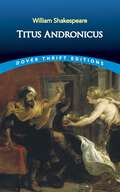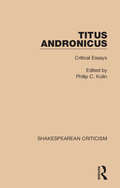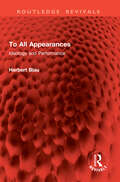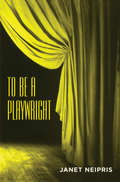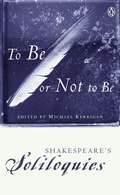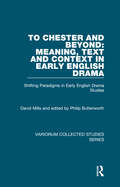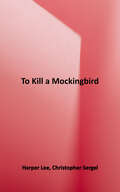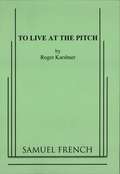- Table View
- List View
Timon of Athens
by William ShakespeareAfter squandering his wealth with prodigal generosity, a rich Athenian gentleman finds himself deep in debt. Unshaken by the prospect of bankruptcy, he is certain that the friends he has helped so often will come to his aid. But when they learn his wealth is gone, he quickly finds that their promises fall away to nothing in this tragic exploration of power, greed, and loyalty betrayed.
Timon of Athens (Dover Thrift Editions)
by William ShakespeareA wealthy citizen of ancient Greece, Timon delights in entertaining his friends and lavishing them with extravagant gifts. His largesse ultimately exceeds his means, and when creditors begin to press him for repayment, the open-handed host is devastated to discover that the guests -- who gladly accepted everything he had -- have now turned their backs on him. Profoundly disillusioned, Timon forswears society and retreats to the wilderness, where further discoveries await.In this deeply cynical drama, Shakespeare tells a thought-provoking tale of conspicuous consumption, debt, ruin, and misanthropy. Combining elements of tragedy, satire, and farce, Timon of Athens poses ever-relevant questions about the meaning of friendship, generosity, and gratitude.
Timon of Athens: A Tragedy - Primary Source Edition (The Pelican Shakespeare)
by William ShakespeareThe acclaimed Pelican Shakespeare series edited by A. R. Braunmuller and Stephen Orgel The legendary Pelican Shakespeare series features authoritative and meticulously researched texts paired with scholarship by renowned Shakespeareans. Each book includes an essay on the theatrical world of Shakespeare’s time, an introduction to the individual play, and a detailed note on the text used. Updated by general editors Stephen Orgel and A. R. Braunmuller, these easy-to-read editions incorporate over thirty years of Shakespeare scholarship undertaken since the original series, edited by Alfred Harbage, appeared between 1956 and 1967. With definitive texts and illuminating essays, the Pelican Shakespeare will remain a valued resource for students, teachers, and theater professionals for many years to come. For more than seventy years, Penguin has been the leading publisher of classic literature in the English-speaking world. With more than 1,700 titles, Penguin Classics represents a global bookshelf of the best works throughout history and across genres and disciplines. Readers trust the series to provide authoritative texts enhanced by introductions and notes by distinguished scholars and contemporary authors, as well as up-to-date translations by award-winning translators.
Tin Bucket Drum: A play
by Neil CoppenThrough a lyrical script and the creative use of lighting and sound, one woman, the Narrator, succeeds in evoking a host of characters as this allegorical tale of oppression and liberation plays itself out. On a 'cold and starless night' a young pregnant widow, Nandi, arrives in Tin Town, a bleak, drought-stricken place ruled by silence and fear. Little do the inhabitants know that Nandi is carrying the baby who will, in time, change that. Taken in by Umkhulu (grandfather), whose father established the tin bucket factory that gave the town its name, Nandi gives birth to Nomvula, the Little Drummer Girl. Umkhulu remembers a past when 'people were free to sing and dance', when the rain came and the townsfolk held up their tin buckets to catch the precious, life-giving drops. And then came the Silent Sir and his spokesman, the Censor, and the town went silent. As the singing and dancing and drumming dried up, so did the rain. The tin bucket factory closed, taking with it the life and purpose of Tin Town?s inhabitants. Only the Little Drummer Girl can bring back that life, but at enormous personal cost. In Tin Bucket Drum, Neil Coppen achieves a small miracle. Through his lyrical script and the creative use of lighting and sound, one woman, the Narrator, succeeds in evoking a host of characters as this allegorical tale of oppression and liberation plays itself out. It is a story that offers a host of lessons for many places and many times.
Tinka's New Dress
by Liz Nicholls Ronnie BurkettTwo old friends become puppeteers, each performing with the same beloved folk characters, Franz and Schnitzel. Fipsi, ambitious and naive, aligns herself with the rule government, the Common Good. Carl, headstrong and outspoken, is forced underground as his satirical shows parody the censorship and oppression of the Common Good. Based on the illegal puppet shows staged in Nazi-occupied Czechoslovakia, Tinka's New Dress examines propaganda versus truth, compliance versus censorship, and the collective society versus the individual.
Tips: Ideas for Directors
by Jon JoryThis book is meant to be a mentor and a reminder, not a chore. Dip into it and use what's helpful at the moment. Are these tips the only way to do a particular thing? Absolutely not. Have they been fire-tested? Yes, I use them every day that I work. Remember, this isn't a method, it's a set of tools, and it's your task to find the right job for them.
Tis Pity She's a Whore (Arden Early Modern Drama Ser.)
by John FordA fully modernised, annotated edition of 'Tis Pity She's a Whore, Ford's controversial tragedy of sibling incest and complex revenge plots. As with all Arden editions, detailed on-page commentary notes help the student understand and appreciate the play both in performance and as a many layered literary text. The lengthy, illustrated introduction offers a wealth of critical and contextual information about the play, and explores its theme of incest from an early modern perspective. Sonia Massai reveals the startling originality of the play, which is far more than a dark rewriting of Romeo and Juliet, and the reasons for its appeal to modern audiences.
Titanic
by Christopher DurangAmid a tangle of changing identities - and sometimes sexes - the action of the play centers on an American family, the Tammurais, who are traveling aboard the Titanic. Comprised of father, mother, brother and sister (or is she actually the Captain’s daughter?) the Tammurais undergo a series of sexual permutations as they reveal all manner of shocking secrets and bizarre fetishes while awaiting the iceberg which, somehow, the ship seems unable to find. The mother tells the father that their son is not really his; the father confesses to the mother that their daughter is not really hers; the daughter mysteriously becomes an aunt who is having an affair with her sister (when she isn’t seducing her nephew); while the father and son compete vigorously for the affections of a handsome young sailor, who is hard put to choose between them. Eventually the ship does go down, taking its odd assemblage of passengers with it, but leaving behind a remarkable array of original thoughts on the nature of the modem American family and the undeniably disturbed society which nurtures it.
Title and Deed / Oh, the Humanity and other good intentions
by Will Eno"A haunting and often fiercely funny meditation on life as a state of permanent exile... The marvel of Mr. Eno's voice is how naturally it combines a carefully sculptured lyricism with sly, poker-faced humor. Everyday phrases and familiar platitudes-'Don't ever change,' 'Who knows'-are turned inside out or twisted into blunt, unexpected punch lines punctuating long rhapsodic passages that leave you happily word-drunk." -Charles Isherwood, New York Times on Title and Deed"Title and Deed is daring within its masquerade of the mundane, spectacular within its minimalism and hilarious within its display of po-faced bewilderment. It is a clown play that capers at the edge of the abyss... Eno's voice is unique; his play is stage poetry of a high order. You can't see the ideas coming in Title and Deed. When they arrive-tiptoeing in with a quiet yet startling energy-you don't quite know how they got there. In this tale's brilliant telling, it is not the narrator who proves unreliable but life itself. The unspoken message of Eno's smart, bleak musings seems to be: enjoy the nothingness while you can." -John Lahr, New Yorker"Eno is a supreme monologist, using a distinctive, edgy blend of non sequiturs and provisional statements to explore the fragility of our existence... There are a lot of words, but they are always exquisitely chosen... Oh, the Humanity reveals that we are beautiful walking tragedies blinking with absurd optimism into the camera lens of history." -Lyn Gardner, GuardianKnown for his wry humor and deeply moving plays, Will Eno's "gift for articulating life's absurd beauty and its no less absurd horrors may be unmatched among writers of his generation" (New York Times). This new volume of the acclaimed playwright's work includes five short plays about being alive-Behold the Coach, in a Blazer, Uninsured; Ladies and Gentlemen, the Rain; Enter the Spokeswoman, Gently; The Bully Composition; and Oh, the Humanity-as well as Title and Deed, a haunting and severely funny solo rumination on life as everlasting exile.WILL ENO is a fellow of Residency Five at Signature Theatre Company in New York. His play The Open House premiered at Signature in 2014, and received an Obie Award, the Lucille Lortel Award for Best Play, and a Drama Desk Special Award. His play The Realistic Joneses premiered at Yale Repertory Theatre in 2012, and was produced on Broadway in 2014, for which he and the cast received a Drama Desk Special Award. His play Title and Deed premiered at Signature in 2012 and was presented at the Edinburgh Fringe Festival in 2014. Both Title and Deed and The Realistic Joneses were included in the New York Times Best Plays List of 2012. Gnit, an adaption of Ibsen's Peer Gynt, premiered at Actors Theatre of Louisville in 2013. Middletown, winner of the Horton Foote Prize, premiered at the Vineyard Theatre in New York in 2010, and was then produced at Steppenwolf Theatre Company in Chicago in 2011. Thom Pain (based on nothing) was a finalist for the 2005 Pulitzer Prize and has been translated into many languages. The Flu Season premiered at the Gate Theatre in London in 2003, and later received the Oppenheimer Award for best New York debut production by an American writer. Tragedy: a tragedy premiered at the Gate Theatre in 2001, and was subsequently produced by Berkeley Repertory Theatre in 2008. Mr. Eno lives in Brooklyn with his wife Maria Dizzia and their daughter Albertine.
Titus Andronicus
by William Shakespeare Russ Mcdonald Stephen Orgel A. R. BraunmullerThe acclaimed Pelican Shakespeare series, now in a dazzling new series design The Pelican Shakespeare series features authoritative and meticulously researched texts paired with scholarship by renowned Shakespeareans. Each book includes an essay on the theatrical world of Shakespeare’s time, an introduction to the individual play, and a detailed note on the text used. Updated by general editors Stephen Orgel and A. R. Braunmuller, these easy-to-read editions incorporate over thirty years of Shakespeare scholarship undertaken since the original series, edited by Alfred Harbage, appeared between 1956 and 1967. With stunning new covers designed by Manuja Waldia, definitive texts, and illuminating essays, the Pelican Shakespeare will remain a valued resource for students, teachers, and theater professionals for many years to come.This edition of Titus Andronicus is edited with an introduction by Russ McDonald.For more than seventy years, Penguin has been the leading publisher of classic literature in the English-speaking world. With more than 1,700 titles, Penguin Classics represents a global bookshelf of the best works throughout history and across genres and disciplines. Readers trust the series to provide authoritative texts enhanced by introductions and notes by distinguished scholars and contemporary authors, as well as up-to-date translations by award-winning translators.From the Trade Paperback edition.
Titus Andronicus
by William Shakespeare Paul Werstine Dr Barbara MowatTitus Andronicus is the earliest tragedy and the earliest Roman play attributed to Shakespeare. Titus, a model Roman, has led 21 of his 25 sons to death in Rome's wars; he stabs another son to death for what he views as disloyalty to Rome. Yet Rome has become "a wilderness of tigers." After a death sentence is imposed on two of his three remaining sons, and his daughter is raped and mutilated, Titus turns his loyalty toward his family. Aaron the Moor, a magnificent villain and the empress's secret lover, makes a similar transition. After the empress bears him a child, Aaron devotes himself to preserving the baby. Retaining his thirst for evil, he shows great tenderness to his little family--a tenderness that also characterizes Titus before the terrifying conclusion. The authoritative edition of Titus Andronicus from The Folger Shakespeare Library, the trusted and widely used Shakespeare series for students and general readers, is now available as an eBook. Features include: · The exact text of the printed book for easy cross-reference · Hundreds of hypertext links for instant navigation · Freshly edited text based on the best early printed version of the play · Full explanatory notes conveniently placed on pages facing the text of the play · Scene-by-scene plot summaries · A key to famous lines and phrases · An introduction to reading Shakespeare's language · Illustrations from the Folger Shakespeare Library's vast holdings of rare books · An essay by a leading Shakespeare scholar providing a modern perspective on the play
Titus Andronicus
by William ShakespeareEach edition includes: · Freshly edited text based on the best early printed version of the play · Full explanatory notes conveniently placed on pages facing the text of the play · Scene-by-scene plot summaries · A key to famous lines and phrases · An introduction to reading Shakespeare's language · An essay by a leading Shakespeare scholar providing a modern perspective on the play · Illustrations from the Folger Shakespeare Library's vast holdings of rare books Essay by Alexander Leggatt. The Folger Shakespeare Library in Washington, D. C. , is home to the world's largest collection of Shakespeare's printed works, and a magnet for Shakespeare scholars from around the globe. In addition to exhibitions open to the public throughout the year, the Folger offers a full calendar of performances and programs. For more information, visit www.folger.edu.
Titus Andronicus
by William ShakespeareThe Roman general Titus is drawn into a violent cycle of revenge when he returns triumphantly to Rome with the Goth queen and her three sons as prisoners.
Titus Andronicus
by William Shakespeare'This is tragedy naked, godless and unredeemed' Kenneth TynanAn embittered Roman general returns from war, having captured the Queen of the Goths and her three sons. Sacrificing the eldest in memory of his own sons killed in battle, he provokes the queen's unending hatred. And when she gains power by her marriage to the new emperor of Rome, she quickly begins to plot a murderous revenge of barely conceivable cruelty, in Shakespeare's first and most savagely bloody tragedy. Used and Recommended by the National TheatreGeneral Editor Stanley WellsEdited by Sonia MassaiIntroduction by Jacques Berthoud
Titus Andronicus & Timon of Athens: Tragedies: Timon Of Athens. Coriolanus. Julius Caesar. Anthony And Cleopatra. Titus Andronicus. Macbeth (Modern Library Classics)
by William Shakespeare Jonathan Bate Eric Rasmussen"These words are razors to my wounded heart."--Titus Andronicus "We have seen better days."--Timon of Athens Eminent Shakespearean scholars Jonathan Bate and Eric Rasmussen provide fresh new editions of the two great tragedies: Titus Adronicus, a graphic story of revenge, and Timon of Athens, a cautionary tale about false friends and unearned loyalty. THIS VOLUME ALSO INCLUDES MORE THAN A HUNDRED PAGES OF EXCLUSIVE FEATURES: * original Introductions to Titus Andronicus and Timon of Athens* incisive scene-by-scene synopsis and analysis with vital facts about the work* commentary on past and current productions based on interviews with leading directors, actors, and designers* photographs of key RSC productions* an overview of Shakespeare's theatrical career and chronology of his plays Ideal for students, theater professionals, and general readers, these modern and accessible editions from the Royal Shakespeare Company set a new standard in Shakespearean literature for the twenty-first century.From the Trade Paperback edition.
Titus Andronicus (Dover Thrift Editions: Plays Ser.)
by William ShakespeareA triumphant general returns to Rome from a war against the Goths and descends into a vicious circle of revenge by refusing to show mercy to his conquered enemy. Blood begets more blood in Titus Andronicus, a fictional drama drawn from a tale by Ovid. Shakespeare styled this early play in the manner of a "revenge tragedy," a genre rooted in classical theater and enormously successful with Elizabethan audiences. Enacting grotesque incidents of rape, murder, and mutilation, this daringly experimental play explores the nature of justice and vengeance.Critical judgment of the drama ranges from dismissal as a panderer's concession to a bloodthirsty mob to praise as a skillful treatment of theatrical violence that examines suffering through the experience of art. Shakespeare's memorable tragedy questions whether revenge is ever justifiable, and its analysis of moral and political issues - betrayal, familial loyalties, sexual violence, nationalism, racism-remains ever relevant.
Titus Andronicus: Critical Essays (Shakespearean Criticism)
by Philip C. KolinOriginally published in 1995. In three parts – introduction, criticism and reviews – this volume examines the goriest of Shakespeare’s works. The editor’s exhaustive introduction runs through the pattern of changing scholarship and commentary, introducing the key interests in the play, from its authorship to its language, rhetoric and performance. Early commentaries focused on arguing about whether the play was truly Shakespeare’s. A selection of the most important of these are included here followed by later investigations looking at myriad topics and characters – revenge, violence, race, Aaron, women, tragedy and Tamora. The large section of reviews of stage performances, arranged chronologically, ranges from 1857 to 1990. Two final pieces interestingly survey stage history of Titus in Japan and in Germany.
To All Appearances: Ideology and Performance (Routledge Revivals)
by Herbert BlauFirst published in 1992, To All Appearances is a book in which ideology and performance shadow each other, in a theoretical inquiry which ranges widely across historical periods and cultures. The author’s concerns—which include the social meaning of illusion and the cultural manifestation of power—take the reader from Jacobean drama to the pageantry of Robert Wilson; from Eleanora Duse to Laurie Anderson; from the puppet theater of Kleist to Kantor’s theater of the dead; and from the Kutiyattam temple dancers in Kerala to Womanhouse in Los Angeles.A brilliant, uncontainable, and chastening look at the rhetoric of critical theory in relation to performance and ideological practice, this is undoubtedly a book for the twenty-first century. It returns us, through all appearances, to the unavoidable question in art, in politics, in the society of the spectacle: what, after all, is the future of illusion?
To Be A Playwright (Routledge Revivals)
by Janet NeiprisOriginally published in 2005, To Be A Playwright is an insightful and detailed guide to the craft of playwriting. Part memoir and part how-to guide, this useful book outlines the tools and techniques necessary to the aspiring playwright. Comprised of a collection of memoirs and lectures which blend seamlessly to deliver a practical hands-on guide to playwriting, this book illuminates the elusive challenges confronting creators of dynamic expression and offers a roadmap to craft of playwrighting.
To Be a Playwright
by Janet NeiprisFirst Published in 2006. Routledge is an imprint of Taylor & Francis, an informa company.
To Be or Not to Be: Shakespeare's Soliloquies
by William ShakespeareA unique collection of Shakespeare's soliloquies, each introduced by concise and informative editorial notes. This is an edition to complement the highly successful SHAKESPEARE'S SONNETS and is published in commemoration of Shakespeare's birthday. Aperfect book for Shakespeare lovers and enthusiasts.
To Chester and Beyond: Shifting Paradigms in Early English Drama Studies
by David MillsThis volume brings together a selection of the major articles of David Mills (1938-2013), which along with similar volumes by Alexandra F. Johnston, Peter Meredith and Meg Twycross makes up a set of "Shifting Paradigms in Early English Drama Studies". Mills was one of these four key scholars whose work has changed what is known about English medieval drama and theatre. He made major contributions to understanding English medieval theatre in the widest sense but more specifically to the nature and development of medieval plays and their performance at Chester. The scope of his work from manuscript to performance has created new knowledge and insights brought about by his remarkable technical skill as an editor and researcher. His texts of the Chester Cycle of Mystery Plays have become the standard works. In the light of this outstanding research the volume is comprised of four sections: 1. Editors and Editing; 2. Cultural Contexts; 3. Staging and Performance; 4. Criticism and Evaluation. An editorial introduction opens the work.
To Kill a Mockingbird
by Harper LeeDrama Revised Version Cast: 11m., 6w. flexible, extras. Scout, a young girl in a quiet southern town, is about to experience the dramatic events that will affect the rest of her life. She and her brother, Jem, are being raised by their widowed father, Atticus. The black people of the community have a special feeling about Scout's father and she doesn't know why. Atticus, a lawyer, explains that he's defending a young Negro wrongfully accused of a grave crime. Atticus fights his legal battle with a result that is part defeat, part triumph. Adapted by Christopher Sergel. From the novel by Harper Lee.
To Live at the Pitch
by Roger KarshnerComedy / 7m, 1f / Interior / Adamdong Klosterhagen, a lovable eccentric and self-proclaimed scientist, has a goal of resuscitating one of his frozen animals. Assisted in his endeavors by his sex-obsessed companion, Ophelia Rass, and wacky dentist friend, Jackson P. Langworthy, he brings to life a squirrel who manifests itself as life-size species named Pascal Dillday, a world-wise character in one of his many reincarnations. Throw into this dizzy mix a live-in cheerleader and an IRS agent who comes to collect back taxes and you have a madcap romp of outrageous proportions.
